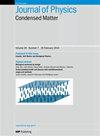控制超导态的圆偏振辐射:稳定性分析
IF 2.3
4区 物理与天体物理
Q3 PHYSICS, CONDENSED MATTER
引用次数: 0
摘要
最近,有人提出利用圆偏振辐射在暴露于半量子磁通的超导纳米环中实现不同量子态之间的按需切换。然而,这种方法的有效性取决于系统对环的超导特性局部变化和磁通波动的稳定性。在本研究中,我们利用基于时间相关金兹堡-朗道(TDGL)方程的数值模拟来评估这些不可避免的因素对开关行为的影响。结果表明,开关现象仍然非常稳定,这为实验观察提供了信心。本文章由计算机程序翻译,如有差异,请以英文原文为准。
Circularly polarized radiation to control the superconducting states: stability analysis.
Recently, the use of circularly polarized radiation for on-demand switching between distinct quantum states in a superconducting nanoring exposed to half-quantum magnetic flux has been proposed. However, the effectiveness of this method depends on the system's stability against local variations in the superconducting characteristics of the ring and flux fluctuations. In this study, we utilize numerical simulations based on the time-dependent Ginzburg-Landau equation to evaluate the influence of these inevitable factors on the switching behavior. The results obtained demonstrate that the switching phenomena remain remarkably robust, providing confidence in their experimental observation.
求助全文
通过发布文献求助,成功后即可免费获取论文全文。
去求助
来源期刊

Journal of Physics: Condensed Matter
物理-物理:凝聚态物理
CiteScore
5.30
自引率
7.40%
发文量
1288
审稿时长
2.1 months
期刊介绍:
Journal of Physics: Condensed Matter covers the whole of condensed matter physics including soft condensed matter and nanostructures. Papers may report experimental, theoretical and simulation studies. Note that papers must contain fundamental condensed matter science: papers reporting methods of materials preparation or properties of materials without novel condensed matter content will not be accepted.
 求助内容:
求助内容: 应助结果提醒方式:
应助结果提醒方式:


